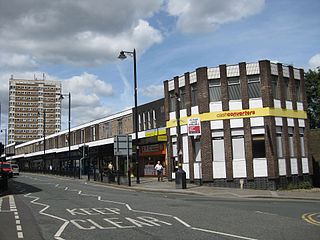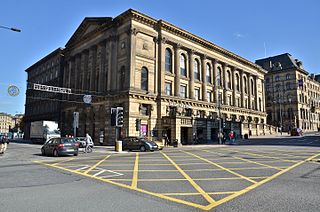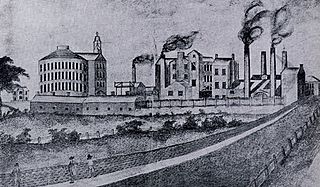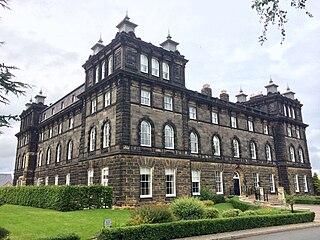
Armley is a district in the west of Leeds, West Yorkshire, England. It starts less than 1 mile (1.6 km) from Leeds city centre. Like much of Leeds, Armley grew in the Industrial Revolution and had several mills, one of which houses now the Leeds Industrial Museum at Armley Mills. Armley is predominantly and historically a largely working class area of the city, still retains many smaller industrial businesses, and has many rows of back-to-back terraced houses.

Harehills is an inner-city area of east Leeds, West Yorkshire, England. It is approximately 1 mile (1.6 km) north east of Leeds city centre. Harehills is situated between the A58 and the A64. It sits in the Gipton & Harehills ward of Leeds City Council and the Leeds East parliamentary constituency, between Burmantofts and Gipton, and adjacent to Chapeltown.

Seacroft is an outer-city suburb/township consisting mainly of council estate housing covering an extensive area of east Leeds, West Yorkshire, England. It lies in the LS14 Leeds postcode area, around 4 miles (6.4 km) east of Leeds city centre.

Bramley is a district in west Leeds, West Yorkshire, England. It is part of the City of Leeds Ward of Bramley and Stanningley with a population of 21,334 at the 2011 Census. The area is an old industrial area with much 19th century architecture and 20th century council housing in the east and private suburban housing in the west.

Lister's Mill was the largest silk factory in the world. It is located in the Manningham district of Bradford, West Yorkshire, England and was built by Samuel Cunliffe Lister to replace the original Manningham Mills that were destroyed by fire in 1871. The mill is a Grade II* listed building, built in the Italianate style of Victorian architecture.

Wakefield Westgate railway station is a mainline railway station in Wakefield, West Yorkshire, England. It is 10 miles (16 km) south of Leeds to the west of the city centre, on the Wakefield Line and Leeds branch of the East Coast Main Line.

Eccleshill is an area, former village, and ward within the City of Bradford Metropolitan District Council in the county of West Yorkshire, England. The ward population of Eccleshill is 17,540, increasing at the 2011 Census to 17,945. Eccleshill is a more or less completely residential urban area with very little open space although there is substantial open land directly to the east.

Briggate is a pedestrianised principal shopping street in Leeds city centre, England. Historically it was the main street, leading north from Leeds Bridge, and housed markets, merchant's houses and other business premises. It contains many historic buildings, including the oldest in the city, and others from the 19th and early-20th century, including two theatres. It is noted for the yards between some older buildings with alleyways giving access and Victorian shopping arcades, which were restored in late 20th century. The street was pedestrianised in the early-21st century.

Quarry Hill is an area of central Leeds, West Yorkshire, England. It is bounded by the Leeds Inner Ring Road in the east and north and the Leeds – York / Hull railway in the south. The area falls within the City and Hunslet ward of Leeds City Council.

The Headrow is an avenue in Leeds city centre, West Yorkshire, England.

Forster Square in central Bradford was redeveloped in the (2006) Broadway development, but gives its name to Bradford Forster Square railway station and a retail park.

St George's Hall is a strategic grade II* listed Victorian building located in the centre of Bradford, West Yorkshire, England. Originally designed with a seating capacity of 3,500, the hall seats up to 1,350 people and 1,550 for standing concerts. It is one of the oldest concert halls still in use in the United Kingdom. German Jewish wool merchants who had moved to Bradford because of its textile industry, partly financed the building of St George's Hall, and were instrumental in its construction.

The Round Foundry is a former engineering works off Water Lane in Holbeck, Leeds, West Yorkshire, England. Founded in the late 18th century, the building was developed into the Round Foundry Media Centre in 2005.

The architecture of Leeds, a city and metropolitan borough in West Yorkshire, England, encompasses a wide range of architectural styles and notable buildings. As with most northern industrial centres, much of Leeds' prominent architecture is of the Victorian era. However, the City of Leeds also contains buildings from as early as the Middle Ages such as Kirkstall Abbey, one of Britain's best preserved ruined Cistercian monasteries, as well as examples of 20th century industrial architecture, particularly in the districts of Hunslet and Holbeck.

Bradford is a city in the county of West Yorkshire, England. It lies in the Pennines eastern foothills.

The Milligan and Forbes Warehouse in Bradford, West Yorkshire, England is a grade II listed building built as the eponymous stuff merchants' warehouse in the 19th century. It is considered the city's first building in the Palazzo style and was very influential on 19th century Bradford architecture.

139-153 Sussex Street is a heritage-listed former warehouse and now hotel located at 139-153 Sussex Street, in the Sydney central business district, in the City of Sydney local government area of New South Wales, Australia. It was built from 1850. It is also known as Warehouses (former) and Shops/Warehouses. The property is owned by Property NSW, an agency of the Government of New South Wales. It was added to the New South Wales State Heritage Register on 2 April 1999.
Alfred Hill Thompson, ARIBA was an English architect in the Gothic Revival and Arts and Crafts styles, who specialised in small schools and chapels in the Yorkshire area. In partnership with Isaac Thomas Shutt he co-designed the Church of All Saints, Harlow Hill, completed in 1871.

Wells House is a large former hydropathic establishment and hotel in Ilkley, West Yorkshire, England, now used as private apartments. It was built in 1854–56 to a design by the architect Cuthbert Brodrick and is a Grade II listed building. It is located above the town on Wells Road at the edge of Ilkley Moor, giving it an unobstructed view across Wharfedale from its north front. It was originally set in grounds by the landscaper Joshua Major though these gardens have mostly been built on since.

The Burley Branch Library was open on Cardigan Road, Burley, Leeds, West Yorkshire, between 1926 and 2016. It was established on vacant industrial land adjacent to a printing works and railway depot by Leeds City Council, and was majority financed by Carnegie. It is built to a design by Gilbert Burdett Howcroft. The Council closed the library in February 2016 due to its poor condition and being surplus to operational requirements. The building was listed at Grade II in 2017 and remains awaiting redevelopment.




















